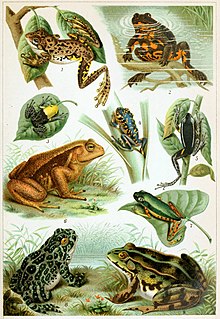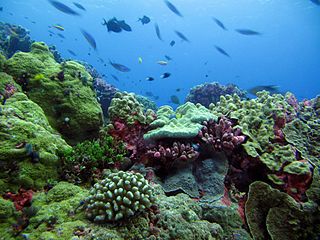Craugastor azueroensis is a species of frog in the family Craugastoridae. It is endemic to Panama. Its natural habitats are subtropical or tropical dry forests, subtropical or tropical moist montane forests, and rivers. It is threatened by habitat loss.
Craugastor chac is a species of frog in the family Craugastoridae. It is found in Belize, Guatemala, and Honduras. Its natural habitats are subtropical or tropical moist lowland forests, subtropical or tropical moist montane forests, plantations, and heavily degraded former forest. It is threatened by habitat loss.
Craugastor coffeus is a species of frog in the family Craugastoridae. It is found in Honduras and possibly Guatemala. Its natural habitats are subtropical or tropical moist montane forests and plantations . It is threatened by habitat loss.

Craugastor crassidigitus is a species of frog in the family Craugastoridae. It is found in Colombia, Costa Rica, Panama, and possibly Nicaragua. Its natural habitats are subtropical or tropical moist lowland forests, subtropical or tropical moist montane forests, arable land, pastureland, plantations, and heavily degraded former forest.
Craugastor daryi is a species of frog in the family Craugastoridae. It is endemic to Guatemala. Its natural habitats are subtropical or tropical moist montane forests, rivers, and intermittent rivers. It is threatened by habitat loss.
Craugastor epochthidius is a species of frog in the family Craugastoridae. It is endemic to Honduras. Its natural habitats are subtropical or tropical moist lowland forests, subtropical or tropical moist montane forests, and rivers. It is threatened by habitat loss.
Craugastor fecundus is a species of frog in the family Craugastoridae. It is endemic to Honduras. Its natural habitats are subtropical or tropical moist lowland forests, subtropical or tropical moist montane forests, and rivers. It is threatened by habitat loss.
Craugastor gulosus is a species of frog in the family Craugastoridae. It is found in Costa Rica and Panama. Its natural habitat is subtropical or tropical moist montane forests. It is threatened by habitat loss.
Craugastor hobartsmithi is a species of frog in the family Craugastoridae. It is endemic to Mexico. Its natural habitats are subtropical or tropical dry forests and subtropical or tropical moist montane forests. It is threatened by habitat loss.
Craugastor loki is a species of frog in the family Craugastoridae. It is found in Belize, El Salvador, Guatemala, Honduras, and Mexico. Its natural habitats are subtropical or tropical moist lowland forests, subtropical or tropical moist montane forests, plantations, and rural gardens. It is threatened by habitat loss.
Craugastor melanostictus is a species of frog in the family Craugastoridae. It is found in Costa Rica and Panama. Its natural habitat is subtropical or tropical moist montane forests. It is threatened by habitat loss.
Craugastor mexicanus is a species of frog in the family Craugastoridae. It is endemic to Mexico. Its natural habitat is subtropical or tropical moist montane forests. It is threatened by habitat loss.
Craugastor polymniae is a species of frog in the family Craugastoridae. It is endemic to Mexico. Its natural habitat is subtropical or tropical moist montane forests. It is threatened by habitat loss.
Craugastor psephosypharus is a species of frog in the family Craugastoridae. It is found in Belize, Guatemala, and possibly Honduras. Its natural habitats are subtropical or tropical moist lowland forests, subtropical or tropical moist montane forests, rocky areas, and caves. It is threatened by habitat loss.
Craugastor pygmaeus is a species of frog in the family Craugastoridae. It is found in Guatemala and Mexico. Its natural habitats are subtropical or tropical moist lowland forests and subtropical or tropical moist montane forests. It is threatened by habitat loss.

Craugastor rugulosus is a species of frog in the family Craugastoridae. It is endemic to Mexico. Its natural habitats are subtropical or tropical dry forests, subtropical or tropical moist montane forests, and rivers. It is threatened by habitat loss.
Craugastor stejnegerianus is a species of frog in the family Craugastoridae. It is found in Costa Rica and Panama. Its natural habitats are subtropical or tropical dry forests, subtropical or tropical moist lowland forests, subtropical or tropical moist montane forests, pastureland, plantations, and heavily degraded former forest. It is threatened by habitat loss.
Craugastor vocalis is a species of frog in the family Craugastoridae. It is endemic to Mexico. Its natural habitats are subtropical or tropical dry forests and subtropical or tropical moist montane forests. It is threatened by habitat loss.
Craugastor emleni is a species of frog in the family Craugastoridae. It is endemic to Honduras. Its natural habitats are subtropical or tropical moist montane forests, rivers, and plantations.
Craugastor olanchano is a species of frog in the family Craugastoridae. It is endemic to Honduras. Its natural habitats are subtropical or tropical moist montane forests and rivers.







